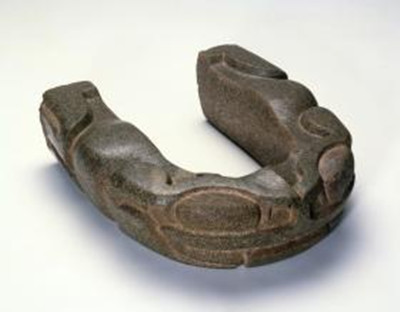They were ball players, they lived in the underworld, and they played ball with the lords of death, regardless of who was playing that game.
他们都是球员,生活在地下,与死神一起玩球。
It re-emphasised how Mesoamericans viewed themselves in the cosmos and in relation to the gods.
这种游戏再次突显了中美洲人的自我定位及其与神灵的关系。
So they were playing out a game of gods and the lords of death every time they took to the ball court."
每次球赛都是天神与死神间的较量。
It used to be thought that the losing team was always sacrificially slaughtered, but while this did later occasionally happen, at the time of our belt we don't know what lay in store for the losers.
过去通常认为,战败的队伍会被杀死祭神。尽管之后这样的情况偶有发生,但其实我们并清楚,在制作腰带的年代,人们究竟会如何处置战败的队伍。
Mostly the games were an opportunity for a community to feast, to worship and to create and reaffirm social ties.
比赛是举办宴会、祭祀和加强社交往来的好时机。
It's thought that early on this was a game that both men and women could play, but by the time the Spanish encountered the Aztecs in the sixteenth century the game was being played only by men.
有人认为,最早的比赛是男女都能参加的,但到十六世纪西班牙人进入美洲时,它已变成了纯男性的比赛。
The ball courts were designed to be sacred spaces in which offerings were buried, so making the building a living entity.
球场也是圣地,祭品埋在地下,使得建筑本身成了有生命的实体。
The Spanish recognised the religious significance of the courts and of course wanted to replace the old local pagan religion with their new, superior, Catholic one.
西班牙人认识到了这些场地在宗教上的重要性,同时又想用天主教来代替当地宗教。
It cannot have been by accident that they built their cathedral in what is today Mexico City on the site of the Great Ball Court of the ancient Aztec city, Tenochtitlan.
因此,他们把天主教堂修在了当年阿兹特克的特诺奇蒂特兰城(今墨西哥城)大球场的位置绝非偶然。
But if the courts were destroyed, the game survived the brutal conquest of Mexico and the destruction of the Aztec culture.
但尽管球场已被摧毁或废弃,在经历了殖民者对墨西哥的野蛮掠夺及对阿玆特克文化的粗暴毁灭之后,球赛依然存活了下来。
A form of it is even played today, called 'ulama', proof, if any was needed, that once a sport embodies national identity as this one does, it has enormous staying power.
一种名叫乌拉马的球赛今天仍在举行,这证明了—如果需要证明的话—假如一种运动与国家的认同感相关,它的生命力是极为强大的。



